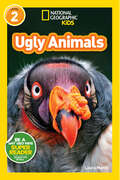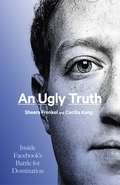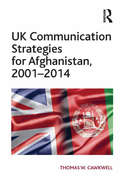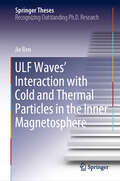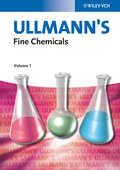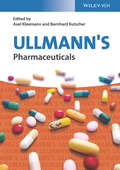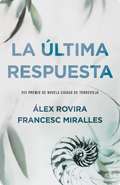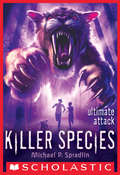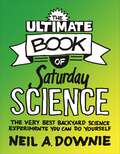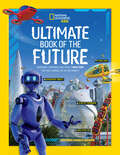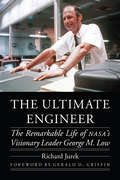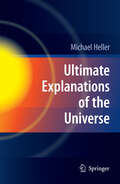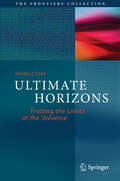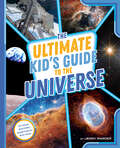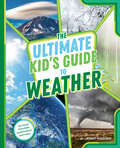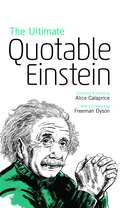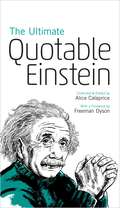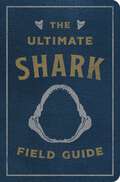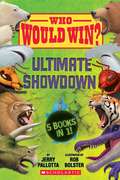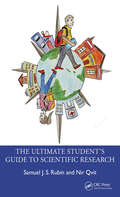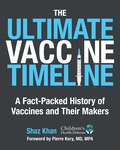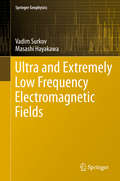- Table View
- List View
Ugly Animals (Readers)
by Laura MarshSometimes, the uglier, the better! In this level 2 reader, young readers will meet the ugliest of animals. Follow these funny-looking creatures and learn how their strange looks help them in the wild. Interesting photos and carefully leveled text make this book perfect for reading aloud or for independent reading.
An Ugly Truth: Inside Facebook's Battle for Domination
by Sheera Frenkel Cecilia Kang'The ultimate takedown' New York Times'The problem of Facebook is Zuckerberg. And the question posed by this splendid book is: what are we going to do about him?' Observer'A comprehensive account . . . drawn from first-hand testimonies. Thoroughly engaging' The Times'What marks this book out is how it gets under the corporate bonnet . . . to build a picture of astounding corporate arrogance and irresponsibility' Sunday Times'An explosive new book' Daily Mail__________________________________________Award-winning New York Times reporters Sheera Frenkel and Cecilia Kang unveil the tech story of our times in a riveting, behind-the-scenes exposé that offers the definitive account of Facebook's fall from grace. Once one of Silicon Valley's greatest success stories, for the past five years, Facebook has been under constant fire, roiled by controversies and crises. It turns out that while the tech giant was connecting the world, they were also mishandling users' data, allowing the spread of fake news, and the amplification of dangerous, polarising hate speech. Critics framed the narrative as the irreconcilable conflict between the platform's lofty mission to advance society by bringing people together while also profiting off of them. The company, many said, had simply lost its way. But the truth is far more complex. Drawing on their unrivalled sources, Frenkel and Kang take readers inside the complex court politics, alliances and rivalries within the company, its growing political influence as well as its skirmishes with privacy groups and the FTC, to shine a light on the fatal cracks in the architecture of the tech behemoth. Their explosive, exclusive reporting led them to a shocking conclusion: The missteps of the last five years were not an anomaly but an inevitability - this is how the platform was built to perform. In a period of great upheaval, growth has remained the one constant under the leadership of Mark Zuckerberg and Sheryl Sandberg. Each has stood by as their technology is co-opted by hate-mongers, criminals and corrupt political regimes across the globe, with devastating consequences. In An Ugly Truth, they are at last held accountable.
An Ugly Truth: Inside Facebook's Battle for Domination (Language Acts and Worldmaking #29)
by Sheera Frenkel Cecilia Kang'The ultimate takedown' New York Times'The problem of Facebook is Zuckerberg. And the question posed by this splendid book is: what are we going to do about him?' Observer'A comprehensive account . . . drawn from first-hand testimonies. Thoroughly engaging' The Times'What marks this book out is how it gets under the corporate bonnet . . . to build a picture of astounding corporate arrogance and irresponsibility' Sunday Times'An explosive new book' Daily Mail__________________________________________Award-winning New York Times reporters Sheera Frenkel and Cecilia Kang unveil the tech story of our times in a riveting, behind-the-scenes exposé that offers the definitive account of Facebook's fall from grace. Once one of Silicon Valley's greatest success stories, for the past five years, Facebook has been under constant fire, roiled by controversies and crises. It turns out that while the tech giant was connecting the world, they were also mishandling users' data, allowing the spread of fake news, and the amplification of dangerous, polarising hate speech. Critics framed the narrative as the irreconcilable conflict between the platform's lofty mission to advance society by bringing people together while also profiting off of them. The company, many said, had simply lost its way. But the truth is far more complex. Drawing on their unrivalled sources, Frenkel and Kang take readers inside the complex court politics, alliances and rivalries within the company, its growing political influence as well as its skirmishes with privacy groups and the FTC, to shine a light on the fatal cracks in the architecture of the tech behemoth. Their explosive, exclusive reporting led them to a shocking conclusion: The missteps of the last five years were not an anomaly but an inevitability - this is how the platform was built to perform. In a period of great upheaval, growth has remained the one constant under the leadership of Mark Zuckerberg and Sheryl Sandberg. Each has stood by as their technology is co-opted by hate-mongers, criminals and corrupt political regimes across the globe, with devastating consequences. In An Ugly Truth, they are at last held accountable.
UK Communication Strategies for Afghanistan, 2001–2014
by Thomas W. CawkwellThe war in Afghanistan came to an end in 2014 after nearly thirteen years of conflict. Throughout that period, British officials have described UK operations there in various conflicting and often contradictory ways; as a counter-terrorism mission, a stabilisation mission, and a counter-narcotics mission, respectively. This book investigates how the war was ’sold’ to the British public and how Britain’s ’transnational’ foreign and defence policy impacted on the unfolding of UK strategy in Afghanistan and the way it was communicated. It argues that because the UK’s foreign and defence policy is transnationally-oriented - meaning that it is foundationally aimed at maintaining alliance with the United States and the institutional coherence of NATO - UK strategy is contingent upon collective security and, crucially, is fundamentally concerned with the means of policy (maintaining alliances) over the ends (using alliances to effect change). Explaining the inalienability of collective security systems to national security is no easy task, however, and, when faced with the adversities of Afghanistan, the UK state has since 2008 instead opted to describe the significance of Afghanistan in narrow, nation-centric, counter-terrorist concerns in order to maintain public support for collective security operations there whilst, paradoxically, framing the conflict in a manner that avoids talking about the transnational structure and purpose of the mission. This kind of ’strategic’ communication is increasingly becoming a focus of the UK state as it faces a transnational dilemma of maintaining its collective security bonds whilst facing a public increasingly sceptical of liberal interventionism.
ULF Waves’ Interaction with Cold and Thermal Particles in the Inner Magnetosphere (Springer Theses)
by Jie RenThis thesis focuses on ULF (Ultra-low-frequency) waves' interaction with plasmasphere particles and ring current ions in the inner magnetosphere. It first reports and reveals mutual effect between ULF waves and plasmasphere using Van Allen Probes data. The differences and similarities of different ring current ions interacting with ULF waves are extensively explored using Cluster data, which provides a potential explanation for O+-dominated ring current during the magnetic storms. Furthermore, this thesis finds a method to study the phase relationship between ULF waves and drift-bounce resonant particles, and proposes that the phase relationship can be used to diagnose the parallel structure of standing wave electric field and energy transfer directions between waves and particles. The findings in this thesis can significantly promote our understanding of ULF waves' role in the dynamics of inner magnetosphere.
Ullmann's Fine Chemicals
by UllmannA compilation of 76 articles from the ULLMANN's Encyclopedia of Industrial Chemistry, this three-volume handbook contains a wealth of information on the production and industrial use of more than 2,000 of the most important fine chemicals, from "Alcohols" to "Urea Derivatives". Chemical and physical characteristics, production processes and production figures, main uses, toxicology and safety information are all found here in one single resource. Order your copy now and benefit from the introductory offer! Introductory price, valid until 30 June 2014: US $575. 00 / £350. 00 / e429. 00 List price thereafter: US $675. 00 / £410. 00 / e499. 00
Ullmann's Pharmaceuticals
by Axel Kleemann Bernhard KutscherBased on the WHO's Anatomical Therapeutical Chemical drug classification system, virtually all marketed therapeutics are covered here in 46 topical and systematic articles. Each carefully selected section contains a general introduction to the therapeutic class, current developments and challenges, followed by a systematic listing of all important products. For each therapeutic, up-to-date information on compound structure, mechanism, pharmacology, clinical use, time on market, and production methods is provided, complete with references to the scientific and patent literature. With all articles either rewritten or completely updated to include marketed drugs up to 2021, this unique reference provides reliable data on more than 2,000 products, making it an indispensable guide for every professional in the pharmaceutical and medical sector.
La última respuesta
by Francesc Miralles Álex Rovira¿Existe una fórmula capaz de cambiar el destino de las personas?Hay una fuerza extremadamente poderosa que puede cambiar nuestra concepción del universo y nuestra propia vida. Hasta ahora nadie ha conseguido encontrar su explicación. Albert Einstein la resolvió en su momento en una ecuación matemática, pero, por un secreto motivo, decidió que permaneciera oculta. Javier, un guionista de radio, perdedor y un poco canalla, y Sarah, una misteriosa y seductora especialista en el genio alemán participarán en una búsqueda llena de peligros y sorpresas que les llevará a los lugares en los que vivió, trabajó, sufrió y amó el premio Nobel más famoso de todos los tiempos. Lo que desconocen es que su aventura en busca de la última respuesta será ante todo un viaje iluminador hacia lo más profundo de ellos mismos.Los autores revelan en esta novela cómo canalizar positivamente la energía más secreta y poderosa que guardamos en nuestro interior. El primer thriller inspiracional.
Ultimate Attack: Ultimate Attack (Killer Species #4)
by Michael P. SpradlinThe action-packed series by Michael P. Spradlin returns. Each book covers a genetically engineered superpredator wreacking havoc on the environment.It's all come to this.Dr. Catalyst has had enough of Emmet Doyle's meddling. Time after time, Emmet and his friend Calvin Geaux have stepped in to ruin his plans, just when he'd released one of his genetically engineered killer species into the Florida environment.This time, Dr. Catalyst is releasing his most deadly creation yet. It's a terrifying lone hunter, bred to stalk and destroy one specific target -- Emmet Doyle.
The Ultimate Book of Saturday Science: The Very Best Backyard Science Experiments You Can Do Yourself
by Neil A. DownieThe best backyard experiments for hands-on science learningThe Ultimate Book of Saturday Science is Neil Downie's biggest and most astounding compendium yet of science experiments you can do in your own kitchen or backyard using common household items. It may be the only book that encourages hands-on science learning through the use of high-velocity, air-driven carrots.Downie, the undisputed maestro of Saturday science, here reveals important principles in physics, engineering, and chemistry through such marvels as the Helevator—a contraption that's half helicopter, half elevator—and the Rocket Railroad, which pumps propellant up from its own track. The Riddle of the Sands demonstrates why some granular materials form steep cones when poured while others collapse in an avalanche. The Sunbeam Exploder creates a combustible delivery system out of sunlight, while the Red Hot Memory experiment shows you how to store data as heat. Want to learn to tell time using a knife and some butter? There's a whole section devoted to exotic clocks and oscillators that teaches you how.The Ultimate Book of Saturday Science features more than seventy fun and astonishing experiments that range in difficulty from simple to more challenging. All of them are original, and all are guaranteed to work. Downie provides instructions for each one and explains the underlying science, and also presents experimental variations that readers will want to try.
Ultimate Book of the Future: Incredible, Ingenious, and Totally Real Tech that will Change Life as You Know It
by National Geographic KidsRobot dogs! Jet packs! Cyborgs! Super-sleek space suits! It's not science fiction, it's science reality. And soon, it may be part of everyday life. This book is a jam-packed collection of the coolest tech and wildest ideas that are shaping the world of tomorrow. Blast off for an unbelievably fascinating journey through time, space, and even a holographic pop concert (or two)! With chapters on future cities, space travel, high-tech entertainment, and even saving the world, Future World is a thorough, fun compendium of high-tech gadgets being built today and the coolest stuff tomorrow has to offer, plus the amazing dreamers making it all happen. Special "Could It Happen?" features tackle kids" burning hypothetical questions, like whether Jurassic Park could really exist, or whether a robot could become president. Each chapter also includes a "Future Fail!" that profiles one thing we thought we'd have by now, but don't (like everything from The Jetsons.) And kids will see where they might fit into the picture through the "Jobs of Tomorrow" profiled in each chapter. (Job titles include mind reader, space pilot, and robot-human communicator. Seriously!) This is the perfect book for fans of sci-fi, budding engineers and scientists, lovers of futuristic movies and pop culture, and anyone who has ever dreamed about what tomorrow might look like. With chapters on future cities, space travel, high-tech entertainment, animal-inspired tech, and even saving the world, this book is a thorough, smart, and—at times—even funny guide to life in the future. A fresh, futuristic design; big, exciting images; and chunky, digestible text make even the most complex-seeming tech and science accessible and fun. Plus, seven original, full-spread illustrations—reviewed by an expert futurist—will give kids a glimpse into the world of tomorrow.
The Ultimate Chemical Equations Handbook
by George R. Hague Jane D. SmithThis handbook is a must-have resource for Advanced Placement Chemistry students.
The Ultimate Engineer: The Remarkable Life of NASA's Visionary Leader George M. Low (Outward Odyssey: A People's History of Spaceflight)
by Richard JurekFrom the late 1950s to 1976 the U.S. manned spaceflight program advanced as it did largely due to the extraordinary efforts of Austrian immigrant George M. Low. Described as the &“ultimate engineer&” during his career at NASA, Low was a visionary architect and leader from the agency&’s inception in 1958 to his retirement in 1976. As chief of manned spaceflight at NASA, Low was instrumental in the Mercury, Gemini, and Apollo programs. Low&’s pioneering work paved the way for President Kennedy&’s decision to make a lunar landing NASA&’s primary goal in the 1960s. After the tragic 1967 Apollo 1 fire that took the lives of three astronauts and almost crippled the program, Low took charge of the redesign of the Apollo spacecraft, and he helped lead the program from disaster and toward the moon. In 1968 Low made the bold decision to go for lunar orbit on Apollo 8 before the lunar module was ready for flight and after only one Earth orbit test flight of the command and service modules. Under Low there were five manned missions, including Apollo 11, the first manned lunar landing. Low&’s clandestine negotiations with the Soviet Union resulted in a historic joint mission in 1975 that was the precursor to the Shuttle-Mir and International Space Station programs. At the end of his NASA career, Low was one of the leading figures in the development of the space shuttle in the early 1970s, and he was instrumental in NASA&’s transition into a post-Apollo world. Afterward, he embarked on a distinguished career in higher education as a transformational president of Rensselaer Polytechnic Institute, his alma mater. Chronicling Low&’s escape from Nazi-occupied Austria to his helping land a man on the moon, The Ultimate Engineer sheds new light on one of the most fascinating and complex personalities of the golden age of U.S. manned space travel.
Ultimate Explanations of the Universe
by Michael HellerWe humans are collectively driven by a powerful - yet not fully explained - instinct to understand. We would like to see everything established, proven, laid bare. The more important an issue, the more we desire to see it clarified, stripped of all secrets, all shades of gray. What could be more important than to understand the Universe and ourselves as a part of it? To find a window onto our origin and our destiny? This book examines how far our modern cosmological theories - with their sometimes audacious models, such as inflation, cyclic histories, quantum creation, parallel universes - can take us towards answering these questions. Can such theories lead us to ultimate truths, leaving nothing unexplained? Last, but not least, Heller addresses the thorny problem of why and whether we should expect to find theories with all-encompassing explicative power.
Ultimate Horizons
by Helmut SatzIn the last hundred years, modern physics and cosmology have shown that there exist regions of the universe forever beyond our reach, hidden by truly ultimate horizons. Such regions exist in those remote parts of the universe where, from our point of view, space expands faster than the speed of light. They are found in black holes, where the gravity is strong enough to retain even light within its field of attraction. And in the realm of the very small, quarks must remain forever confined to their world of extreme density and can never be removed from it. The aim of this book is to describe these ultimate horizons, how they were discovered, how they shape our view of the world, and what clues we have about a world beyond them.
The Ultimate Kid's Guide to the Universe: At-Home Activities, Experiments, and More! (The Ultimate Kid's Guide to...)
by Jenny MarderWith stunning photos of outer space and easy at-home experiments, this is the only guide kids need on their journey of learning about all things astronomy: the stars, the planets, the moon, and so much more!Buckle up and let Jenny Marder, a senior writer for NASA, be your guide to the universe! First stop: the moon!A perfect read for kids, just in time for the April 2024 total solar eclipse!
The Ultimate Kid's Guide to Weather: At-Home Activities, Experiments, and More! (The Ultimate Kid's Guide to...)
by Jenny MarderWith stunning photos of Earth's wildest weather and easy at-home STEM activities, this is the only guide kids need on their journey of learning about all things meteorology.Buckle up and let Jenny Marder, a senior writer for NASA, be your guide through the Earth&’s atmosphere! First stop: the stratosphere!
The Ultimate Quotable Einstein
by Alice Calaprice Freeman Dyson Albert EinsteinHere is the definitive new edition of the hugely popular collection of Einstein quotations that has sold tens of thousands of copies worldwide and been translated into twenty-five languages. The Ultimate Quotable Einstein features 400 additional quotes, bringing the total to roughly 1,600 in all. This ultimate edition includes new sections--"On and to Children," "On Race and Prejudice," and "Einstein's Verses: A Small Selection"--as well as a chronology of Einstein's life and accomplishments, Freeman Dyson's authoritative foreword, and new commentary by Alice Calaprice. In The Ultimate Quotable Einstein, readers will also find quotes by others about Einstein along with quotes attributed to him. Every quotation in this informative and entertaining collection is fully documented, and Calaprice has carefully selected new photographs and cartoons to introduce each section.Features 400 additional quotations Contains roughly 1,600 quotations in all Includes new sections on children, race and prejudice, and Einstein's poetry Provides new commentary Beautifully illustrated The most comprehensive collection of Einstein quotes ever published
The Ultimate Quotable Einstein
by Albert EinsteinThis is the definitive edition of the hugely popular collection of Einstein quotations that has sold tens of thousands of copies worldwide and been translated into twenty-five languages.The Ultimate Quotable Einstein features roughly 1,600 quotes in all. This paperback edition includes sections unique to the ultimate collection--"On and to Children," "On Race and Prejudice," and "Einstein's Verses: A Small Selection"--as well as a chronology of Einstein’s life and accomplishments, Freeman Dyson’s authoritative foreword, and commentary and descriptive source notes by Alice Calaprice.
The Ultimate Shark Field Guide: The Ocean Explorer's Handbook (Sharks, Observations, Science, Nature, Field Guide, Marine Biology for Kids)
by Thomas NelsonSwim alongside your favorite underwater creatures with The Ultimate Shark Field Guide--created as if a marine biologist painted these illustrations and made these notes while out collecting research.Pick up the journal of a marine biologist and discover underwater mysteries with The Ultimate Shark Field Guide. Encounter sharks of all shapes and sizes and note observations on each species' appearance, size, diet, and more. Detailed watercolor illustrations will captivate young readers. This spectacular visual guide gets you up close and personal with some of the fiercest creatures on Earth, including the bull shark, the great white, the Ganges river shark, the whale shark, and the great hammerhead. Explore underwater landscapes with these incredible animals in The Ultimate Shark Field Guide!
Ultimate Showdown (Who Would Win?)
by Jerry Pallotta Robert BolsterWhat if one dangerous animal had a fight with another? Who do you think would win? In this five-book bind-up of the popular Who Would Win? series, kids will learn about each animal's anatomy, behavior, and more. Then compare and contrast the battling pairs before finally discovering the winner! This nonfiction collection is full of facts, photos, and realistic illustrations, and it includes a range of mammals, sea creatures, insects, and dinosaurs to satisfy all kinds of animal fans, including Lion vs. Tiger, Hammerhead vs. Bull Shark, Polar Bear vs. Grizzly Bear, Hornet vs. Wasp, and Triceratops vs. Spinosaurus. <p><p> So who do YOU think would win?
The Ultimate Student’s Guide to Scientific Research
by Samuel J. Rubin Nir QvitA scientific career is a long and winding journey. Many factors assemble to determine the trajectory and products of scientific inquiry. This book addresses the scientific career path comprehensively, ranging from how to build a strong foundational knowledge and skill base, to training programs, composing winning research proposals and grants, conducting excellent research, writing papers and reports, collaborative research programs, bridging academia and industry, career advancement, and more. Guides where, how, and what to study in undergraduate, post-baccalaureate, graduate, and post-graduate training programs and addresses important crossroads throughout the continuum of training and beyond. Highlights best practices, techniques, and nuances for creating a successful scientific career. Provides critical insights for traversing major milestones and decision-points in a scientific career and serves as a resources for reference throughout stages of advancement. Discusses alternative career opportunities for individuals trained in sciences. Offers students, researchers, and other scientists across all stages of their careers with accessible, engaging, and useful insider tips.
The Ultimate Vaccine Timeline: A Fact-Packed History of Vaccines and Their Makers
by Shaz KhanDive deep into a comprehensive fact-packed history of vaccines that includes information on vaccine manufacturers and their evolution over time. Browse through an extensive series of verifiable and documented facts on vaccines. For well over a century, vaccines have been routinely recommended to billions of people worldwide, mostly children and babies. With an ever-increasing portfolio of vaccines using novel technologies on the global market, it is important now more than ever to consolidate a chronology of facts relating to human vaccination. Considering the current climate of censorship around vaccines, this publication will contribute to an expanded understanding of this important medical intervention. Spanning over fifteen hundred years, this thoroughly researched timeline is an educational tool for any researcher, student, doctor, scientist, parent, or curious human being wishing to gain a broader perspective and insight into the complex and vast landscape of human vaccination. From smallpox to shingles; tetanus to tuberculosis; hepatitis B to HPV, discover when, where, and by whom these vaccines were invented and marketed. Including a historical timeline of pharmaceutical company beginnings, mergers and acquisitions since the seventeenth century, this illustrated reference book shines a light on the controversial subject of vaccines and their makers.
Ultra and Extremely Low Frequency Electromagnetic Fields
by Vadim Surkov Masashi HayakawaThe major emphasis of this book is on physical mechanisms and sources of the ULF/ELF natural electromagnetic fields noises. In the course of this text, some of these mechanisms of magnetospheric origin will be treated in detail and others in a more sketchy fashion, while the global electromagnetic resonances excited by lightning activity and other sources are the priority. The interested reader is referred to the books cited in the text for details about the ULF/ELF fields of magnetospheric origin. Much emphasis is put on studies of electromagnetic phenomena caused by rock deformation/fracture including the ULF/ELF effects possibly associated with tectonic activity, earthquakes and other natural disasters. One of the challenges of this research is to fully understand electromagnetic effects and physical processes in the rocks deep in the Earth's crust.
